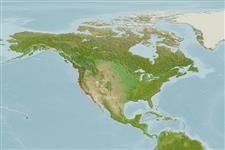>
Acipenseriformes (Sturgeons and paddlefishes) >
Acipenseridae (Sturgeons) > Acipenserinae
Etymology: Acipenser: Latin, acipenser = sturgeon, 1853 (Ref. 45335); transmontanus: The specific name is derived from the Latin acipenser (sturgeon), trans (beyond), and montanus (mountain) (Ref. 27436).
More on author: Richardson.
Environment: milieu / climate zone / depth range / distribution range
Ecologia
marinhas; Água doce; estuarina demersal; anádromo (Ref. 51243); intervalo de profundidade 1 - 122 m (Ref. 27547). Temperate; 0°C - 23°C (Ref. 1998); 58°N - 24°N, 163°W - 107°W (Ref. 54269)
Eastern Pacific: Alaska Bay to Monterey, California, USA. Landlocked in Columbia River drainage, Montana, and perhaps Lake Shasta in California, USA. Translocated to lower Colorado River, Arizona in USA. Reported from northern Baja California, Mexico (Ref. 2850, 27436).
Comprimento de primeira maturação / Tamanho / Peso / Idade
Maturity: Lm 160.0 range ? - ? cm
Max length : 610 cm TL macho/indeterminado; (Ref. 1998); common length : 21.0 cm TL macho/indeterminado; (Ref. 12193); peso máx. publicado: 816.0 kg (Ref. 27436); idade máx. registrada: 104 anos (Ref. 39377)
Espinhos dorsais (total) : 0; Raios dorsais (total) : 44 - 48; Raios anais : 28 - 31. Distinguished by the 2 rows of 4 to 8 bony plates on a midventral line between the anus and anal fin, and about 45 rays in the dorsal fin (Ref. 27547). Gray or brownish above, paler below; fins gray (Ref. 27547). Barbels situated closer to snout tip than to mouth; no obvious scutes behind dorsal and anal fins (Ref. 86798).
Spends most of its time in the sea, usually close to shore (Ref. 27547). Enters estuaries of large rivers and moves far inland to spawn (Ref. 5723). Individuals larger than 48.3 cm feed mainly on fishes; smaller ones feed mainly on chironomids, but also takes small crustaceans, other insects and mollusks (Ref. 1998). Feeding ceases just before spawning (Ref. 1998). Excellent food fish that is sold fresh, smoked or frozen (Ref. 9988). Eggs marketed as caviar (Ref. 1998). In the past, the airbladder was made into isinglass (Ref. 27547).
Adults return to the sea after spawning (Ref. 27547). Spawning frequency interval every 4 years for younger females and every 10-11 years in older females (Ref. 1998).
Page, L.M. and B.M. Burr, 1991. A field guide to freshwater fishes of North America north of Mexico. Houghton Mifflin Company, Boston. 432 p. (Ref. 5723)
Status na Lista Vermelha da UICN (Ref. 130435: Version 2024-1)
Ameaça para os humanos
Harmless
Uso pelos humanos
Pescarias: espécies comerciais; Aquacultura: espécies comerciais; peixe esportivo: sim
Ferramentas
Relatórios especiais
Baixar XML
Fontes da internet
Estimates based on models
Preferred temperature (Ref.
123201): 8.3 - 12.2, mean 9.7 °C (based on 80 cells).
Índice de diversidade filogenética (Ref.
82804): PD
50 = 0.5000 [Uniqueness, from 0.5 = low to 2.0 = high].
Bayesian length-weight: a=0.00302 (0.00153 - 0.00597), b=3.19 (3.02 - 3.36), in cm total length, based on LWR estimates for this species & Genus-body shape (Ref.
93245).
Nível Trófico (Ref.
69278): 3.3 ±0.1 se; based on diet studies.
Generation time: 27.5 ( na - na) years. Estimated as median ln(3)/K based on 1
growth studies.
Resiliência (Ref.
120179): Muito baixo(a), tempo mínimo de duplicação da população maior que 14 anos (tm=11-34; tmax=104).
Fishing Vulnerability (Ref.
59153): Very high vulnerability (87 of 100).
Climate Vulnerability (Ref.
125649): Moderate to high vulnerability (48 of 100).
Nutrients (Ref.
124155): Calcium = 8.84 [4.78, 17.65] mg/100g; Iron = 0.244 [0.136, 0.429] mg/100g; Protein = 17.4 [14.8, 20.2] %; Omega3 = 0.293 [0.147, 0.585] g/100g; Selenium = 31.4 [14.7, 69.3] μg/100g; VitaminA = 4.45 [1.29, 16.47] μg/100g; Zinc = 0.377 [0.252, 0.570] mg/100g (wet weight);
